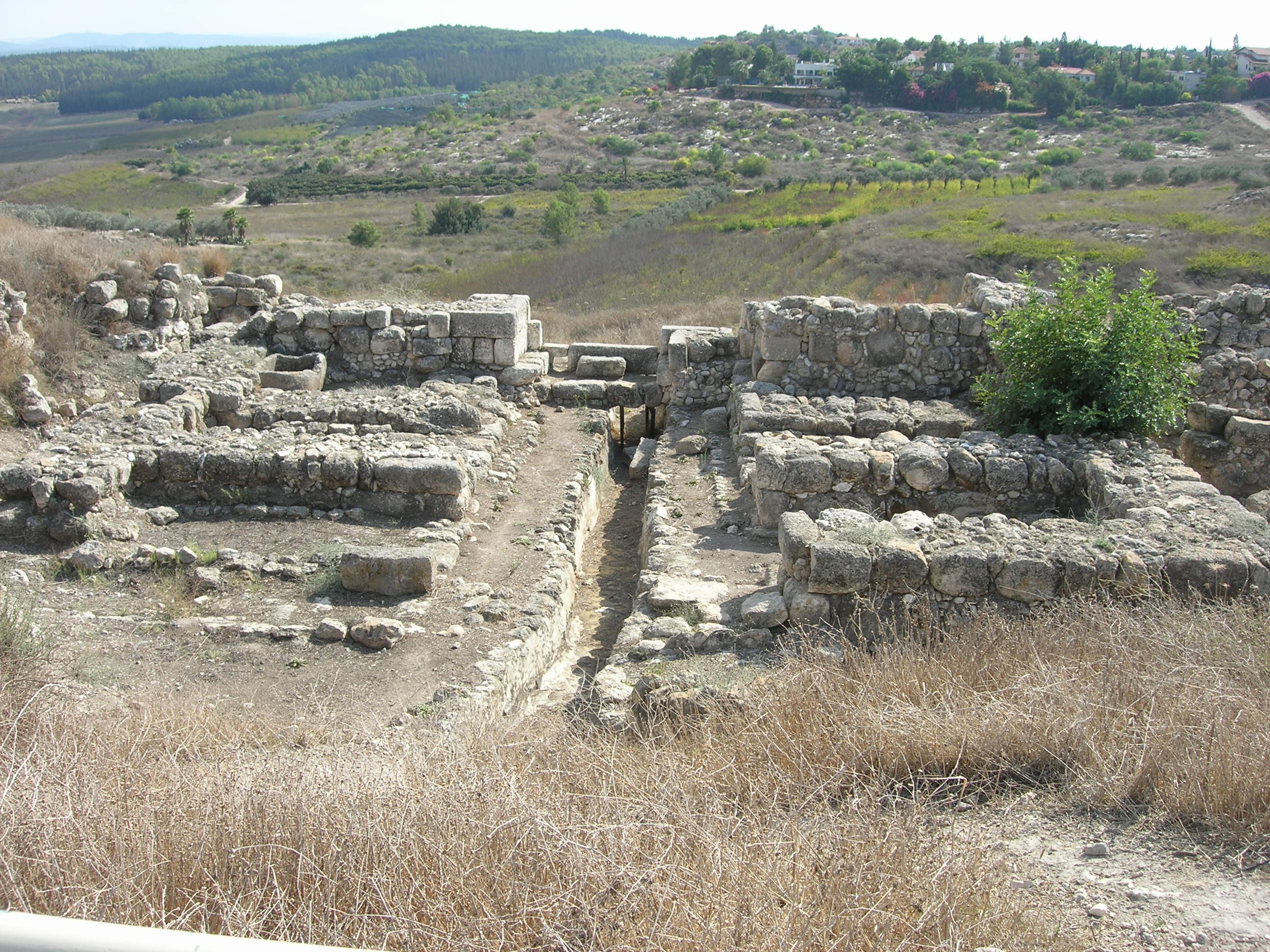The site of Gezer 23 miles northwest of Jerusalem was an important fortified city in Old Testament times. At 30 acres in size, it was one of the largest cities in the foothill region of south-central Israel. It protected the approach to Jerusalem from the west, as it was strategically located at the crossroads of the coastal road along the Mediterranean and the road leading inland to Jerusalem and Transjordan. Gezer has been extensively excavated by several expeditions over the years, but there has been sharp disagreement over the dating of some of the phases of the site. The dates determined by the excavators, based on pottery, produced results that were in good agreement with what the Bible tells us about the history of the site. A number of revisionist scholars, however, led by Israeli scholar Israel Finkelstein, have argued for a lower (more recent) chronology that would throw off previous correlations with the Bible. But a new, in-depth study of radiocarbon dates from the site, carried out by the prestigious Austrian Academy of Sciences, now has fine-tuned the original pottery dating.1
Gezer is first mentioned in the Conquest narrative. Although Joshua and the Israelite forces defeated Horam the Canaanite king of Gezer and his army at Lachish, 30 miles south of Gezer (Jos 10:33), they were not successful in conquering the city itself (Jos 16:10; Jgs 1:29). The Gezerites, though, were required to do forced labor for the Israelites (Jos 16:10). When the land was divided, the city was given to the Kohathites, who served as Tabernacle musicians (Jos 21:20–21; 1 Chr 6:66–67; 1 Chr 6:1–48). At some point, the city fell into Philistine hands, as David (r. 1009–969 BC) recaptured Gezer during his reign (1 Chr 20:4). Gezer was next conquered by the king of Egypt ca. 970 BC: “(Pharaoh king of Egypt had attacked and captured Gezer. He had set it on fire. He killed its Canaanite inhabitants and then gave it as a wedding gift to his daughter, Solomon’s wife” (1 Kgs 9:16; NIV). Solomon (r. 971–932 BC) then used forced labor to rebuild Gezer (1 Kgs 9:15, 9:17). Gezer is not mentioned in the Bible again after Solomon’s reign.
Excavations at Gezer began with those of the Palestine Exploration Fund in 1902–1909. This was followed by Hebrew Union College’s 1964–1974 dig and, more recently, an undertaking sponsored by Southwestern Baptist Theological Seminary (2006–2017). One of the more important finds from these endeavors was the discovery of a magnificent four-entryway (six-chamber) gate from the time of Solomon that measured 46 ft. deep by 56 ft. wide. I have a special interest in this gate, since my archaeology professor at the University of Toronto, John S. Holladay Jr., supervised the excavation of the gate over four seasons, 1967–1970.
The gate and other monumental architecture found in Stratum VIII indicate a powerful and prosperous regime with a well-organized, centralized administration. Carbon 14 dating places Stratum VIII in the tenth century BC, the time of Solomon according to biblical chronology. Finkelstein, however, claimed that Stratum VIII was constructed by Omri of the Northern Kingdom in the ninth century BC. But the authors of the PLOS ONE article cited earlier conclude,
The 10th century BC 14C-based date . . . notably rules out an association with the northern Israelite Omride dynasty (contra [Finkelstein]), however it is chronologically compatible with Saul, David and/or Solomon, whose text-based dating (albeit approximate) falls in the 10th century BC (perhaps also the late 11th century BC). While scholars can debate the degree to which the accounts of these early highland rulers reflect historical memories, extra-biblical evidence indicates they were real historical figures.2
This is a momentous statement since, in addition to Finkelstein’s attempt to disassociate Stratum VIII from Solomon, many other scholars have argued that there was no United Monarchy at all, and that Saul, David, and Solomon were merely legendary figures!
 Foundation of the majestic six-chamber Solomonic gate at Gezer, with an exposed drainage channel visible in the gate passageway. The view is to the southeast, toward the outside of the city. Wikimedia Commons. Creator username: Mickael101. October 30, 2006. Public Domain. https://commons.wikimedia.org/wiki/File:Gezer.JPG.
Foundation of the majestic six-chamber Solomonic gate at Gezer, with an exposed drainage channel visible in the gate passageway. The view is to the southeast, toward the outside of the city. Wikimedia Commons. Creator username: Mickael101. October 30, 2006. Public Domain. https://commons.wikimedia.org/wiki/File:Gezer.JPG.
No evidence was found for the burning of Gezer by an Egyptian king ca. 970 BC (mentioned in 1 Kings 9:16). Stratum IX, however, the phase prior to Solomon’s Stratum VIII, was very limited and ephemeral in nature, which may reflect a destruction of the city by the Egyptian king prior to Solomon’s rebuilding program of Stratum VIII (1 Kgs 9:15, 9:17). A later Egyptian king, Shishak, conquered Jerusalem and many Judahite cities in the fifth year of Solomon’s son Rehoboam, ca. 928 BC (1 Kgs 14:25–26; 2 Chr 12:2–4). This campaign actually involved other sites in the Levant as well, as demonstrated by a record of the event carved on a wall of the Temple of Amun at Karnak in Egypt. Among the 156 defeated cities depicted by this carving, Gezer is missing, but this is no doubt due to the fact that the row recording the defeated cities in Judah is heavily damaged. Because of its strategic location, the city almost certainly was among the “fortified cities of Judah” captured by Shishak (2 Chr 12:4). Gezer Stratum VIII ended in a destruction that most scholars believe was caused by Shishak.3
In the late eighth century BC, the Assyrian king Tiglath-pileser III (r. 744–727 BC; also called Pul) invaded Israel and Judah. Both Menahem king of Israel (r. 752–742 BC) and Ahaz king of Judah (r. 732–716 BC) paid tribute to the invader (2 Kgs 15:19, 16:7–8; 2 Chr 28:16–21). This did not assuage Tiglath-pileser, however. He carried out a destructive campaign in the north, conquering many cities and taking important leaders and whole tribes into exile (2 Kgs 15:29; 1 Chr 5:6, 5:26). Regarding Judah,
Tiglath-Pileser king of Assyria came to him [Ahaz], but he gave him trouble instead of help. Ahaz took some of the things from the temple of the LORD and from the royal palace and from the officials and presented them to the king of Assyria, but that did not help him. (2 Chr 28:20–21; NIV)
We know that Tiglath-pileser campaigned in Judah and, in fact, attacked Gezer, as he commissioned a wall relief commemorating the event. Originally, it was displayed in his palace at Nimrud, but later it was moved to the nearby palace of his great-grandson Esarhaddon (r. 680–669 BC), where it was found. The relief depicts a siege engine battering the crenellated walls of Gezer while the defenders on the wall and in two towers are surrendering. The caption above merely reads, “The city of Gezer.” It is known from Tiglath-pileser’s records that he campaigned in the region of Philistia in 734 BC, so this is the most likely time of his siege of Gezer. In addition, the excavators of Gezer found that Stratum VI, dated to the late eighth century BC, was violently destroyed, with most rooms covered by over six feet of mudbrick destruction debris. They attribute the destruction to Tiglath-pileser III.
When all the evidence is in, it is clear that the archaeological findings and recent radiocarbon dates demonstrate the detailed historical accuracy of the Bible with regard to Gezer. Those who would challenge the biblical record do so in vain.
1 Lyndelle C. Webster, Samuel R. Wolff, Steven M. Ortiz, Marcella Barbosa, Cameron Coyle, Gary P. Arbino, Michael W. Dee, Quan Hua, and Geraldine E. Jacobsen, “The Chronology of Gezer from the End of the Late Bronze Age to Iron Age II: A Meeting Point for Radiocarbon, Archaeology Egyptology and the Bible,” PLOS ONE 18, no. 11 (2023): e0293119. https://doi.org/10.1371/journal.pone.0293119.
2 Webster et al., 25, e0293119.
3 Webster et al., 26, e0293119.











